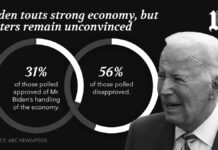The Department of Justice (DOJ) has quietly taken down a series of sections from its website related to both domestic and international child sex trafficking, including a portion that offers information about U.S. minors being “recruited and exploited” into the commercial sex industry.
According to an archived version (see below) of the website, the agency previously provided detailed information about “International Sex Trafficking of Minors,” “Domestic Sex Trafficking of Minors,” and “Child Victims of Prostitution.”
The updated version of the webpage completely erased all three sections, which were added during President Donald Trump’s tenure on May 28, 2020, to counsel Americans about tactics that are being used by pimps and human traffickers targetting vulnerable children and luring them into prostitution and other forms of sexual exploitation using psychological manipulation.
In the top section under “Child Sex Trafficking”—which is still in the updated version of the website—the DOJ also erased the following paragraph.
“After cultivating a relationship with the child and engendering a false sense of trust, the trafficker will begin engaging the child in prostitution, and use physical, emotional, and psychological abuse to keep the child trapped in a life of prostitution. It is common for traffickers to isolate victims by moving them far away from friends and family, altering their physical appearances, or continuously moving them to new locations. Victims are heavily conditioned to remain loyal to the trafficker and to distrust law enforcement.”
The new version shows at the bottom of the website that the DOJ updated it in mid-May, roughly three years after the Trump administration added additional information highlighting how child sex trafficking is a major issue in the United States.
During his time in office, Mr. Trump made fighting human trafficking a key goal of his administration and often spoke publicly about the issue. He signed an executive order in January 2020 aimed to eliminate human trafficking and online child exploitation in the United States, which required resources to be directed into areas that would result in the prosecution of offenders, assist victims, and expand prevention education programs about the issue.
Read Full Article on TheEpochTimes.com
Achieved Version of DOJ Website Below
CHILD SEX TRAFFICKING
“Some of our most vulnerable children also face the threat of being victimized by commercial sexual exploitation. Runaways, throwaways, sexual assault victims, and neglected children can be recruited into a violent life of forced prostitution.”
– Deputy Attorney General James Cole speaks at the National Strategy Conference on Combating Child Exploitation in San Jose, California, May 17, 2011.
Child Sex Trafficking
Child sex trafficking refers to the recruitment, harboring, transportation, provision, obtaining, patronizing, or soliciting of a minor for the purpose of a commercial sex act. Offenders of this crime who are commonly referred to as traffickers, or pimps, target vulnerable children and gain control over them using a variety of manipulative methods. Victims frequently fall prey to traffickers who lure them in with an offer of food, clothes, attention, friendship, love, and a seemingly safe place to sleep. After cultivating a relationship with the child and engendering a false sense of trust, the trafficker will begin engaging the child in prostitution, and use physical, emotional, and psychological abuse to keep the child trapped in a life of prostitution. It is common for traffickers to isolate victims by moving them far away from friends and family, altering their physical appearances, or continuously moving them to new locations. Victims are heavily conditioned to remain loyal to the trafficker and to distrust law enforcement. No child is immune to becoming a victim of child sex trafficking, regardless of the child’s race, age, socioeconomic status, or location, and every child involved in this form of commercial sexual exploitation is a victim.
Technological advances, in particular the Internet and mobile devices, have facilitated the sex trafficking of children by providing a convenient worldwide marketing channel. Individuals can now use websites and social media to advertise, schedule, and purchase sexual encounters with minors. The Internet and mobile devices also allow pimps and traffickers to reach a larger clientele base than in the past, which may expose victims to greater risks and dangers.
Child sex trafficking investigations present unique challenges to law enforcement and require a robust multijurisdictional response, with multiple agencies playing a critical role in ensuring the protection of victims and effective prosecution of offenders. The method by which most traffickers identify, recruit, market, and maintain their victims results in a unique combination of sustained violent criminal behavior with reluctant victims and witnesses. Although interviews of sex trafficking victims frequently identify traffickers and other accomplices, some child victims may resist identifying their traffickers because of fear or other means of manipulation that the pimp has exercised over them. Furthermore, the victim may only know their traffickers’ street name and cannot fully identify their traffickers.
Child sex trafficking victims are often not recognized as victims and may be arrested and jailed. The dangers faced by these children—from the traffickers, their associates, and from customers—are severe. These children become hardened by the treacherous environment in which they must learn to survive. As such, they do not always outwardly present as sympathetic victims. They also frequently suffer from short–term and long–term psychological effects such as depression, self-hatred, and feelings of hopelessness. These child victims also need specialized services that are not widely available given they often have illnesses, drug addictions, physical and sexual trauma, lack of viable family and community ties, and total dependence—physical and psychological—on their abusers.
For more information, see Federal Law on Child Sex Trafficking.
International Sex Trafficking of Minors
One form of sex trafficking involves the cross border transportation of children. In these situations, traffickers recruit and transfer children across international borders in order to sexually exploit them in another country. The traffickers can be individuals working alone, organized crime groups, enterprises, or networks of criminals working together to traffic children into prostitution across country lines.
This form of sex trafficking is a problem in the United States, and recovered victims originate from all over the world, including less-developed areas, such as South and Southeast Asia, Central America, and South America, to more developed areas, such as Western Europe. Once in the United States, a child may be trafficked to any or multiple states within the country. These victims are often trafficked far from home, and thrown into unfamiliar locations and culture. They may be given a false passport or other documentation to conceal their age and true identity. They may also struggle with the English language. All these factors make it extremely difficult for these children to come forward to law enforcement.
In addition, many foreign victims originate from nations that suffer from poverty, turbulent politics and unstable economics. Children from these countries are seen as easy targets by traffickers because they face problems of illiteracy, limited employment opportunities, and bleak financial circumstances in their home country. It is not uncommon for a foreign victim to be coerced by a trafficker under false pretenses. The child is told that a better life or job opportunity awaits them in the United States. However, once in the United States they are introduced into a life of prostitution controlled by traffickers.
Domestic Sex Trafficking of Minors
The United States not only faces a problem of foreign victims trafficked into the country, but there is also a homegrown problem of American children being recruited and exploited for commercial sex. Under federal law, a child does not need to cross international or even state borders to be considered a victim of commercial sexual exploitation, and unfortunately, American children are falling victim to this crime within the United States.
Pimps and traffickers sexually exploit children through street prostitution, and in adult night clubs, illegal brothels, sex parties, motel rooms, hotel rooms, and other locations throughout the United States. Many recovered American victims are street children, a population of runaway or throwaway youth who often come from low income families, and may suffer from physical abuse, sexual abuse and family abandonment issues. This population is seen as an easy target by pimps because the children are generally vulnerable, without dependable guardians, and suffer from low self-esteem. Victims of the prostitution of children, however, come from all backgrounds in terms of class, race, and geography (i.e. urban, suburban, and rural settings).
Often in domestic sex trafficking situations, pimps will make the child victim feel dependent on prostitution for life necessities and survival. For example, a pimp will lure a child with food, clothes, attention, friendship, love, and a seemingly safe place to stay. After cultivating a relationship with a child and engendering a false sense of trust, the pimp will begin engaging the child in prostitution. It is also common for pimps to isolate victims by moving them far away from friends and family, altering their physical appearances, or continuously moving victims to new locations. In many cases, victims become so hardened by the environment in which they must learn to survive that they are incapable of leaving the situation on their own.
Child Victims of Prostitution
The term prostitution can delude or confuse one’s understanding of this form of child sexual exploitation. It is important to emphasize that the children involved are victims. Pimps and traffickers manipulate children by using physical, emotional, and psychological abuse to keep them trapped in a life of prostitution. It is not uncommon for traffickers to beat, rape, or torture their victims. Some traffickers also use drugs and alcohol to control them.
Technological advances, in particular the Internet, have facilitated the commercial sexual exploitation of children by providing a convenient worldwide marketing channel. Individuals can now use websites to advertise, schedule, and purchase sexual encounters with minors. The Internet and web-enabled cell phones also allow pimps and traffickers to reach a larger clientele base than in the past, which may expose victims to greater risks and dangers.
In addition, many child victims suffer from physical ailments, including tuberculosis, infections, drug addition, malnutrition, and physical injuries resulting from violence inflicted upon them. Venereal diseases also run rampant. Children may also suffer from short–term and long–term psychological effects such as depression, low self-esteem, and feelings of hopelessness.
CEOS’s Role
CEOS attorneys work with the High Technology Investigative Unit (HTIU), the Federal Bureau of Investigation (FBI), United States Attorney´s Offices around the country, and other state and local parties to investigate and prosecute cases arising under federal statutes prohibiting the prostitution of children. CEOS works to not only punish and jail offenders, but to protect the rights and welfare of the children involved.
In addition, CEOS maintains a coordinated, national-level law enforcement focus, and helps coordinates nationwide and international investigations and initiatives. CEOS attorneys travel all over the country to conduct trainings for investigators, law enforcement personnel and others involved in efforts to eradicate this crime. Moreover, CEOS designs, implements, and supports law enforcement strategies, legislative proposals, and policy initiatives relating to federal laws prohibiting the prostitution of children.
Updated May 28, 2020














































